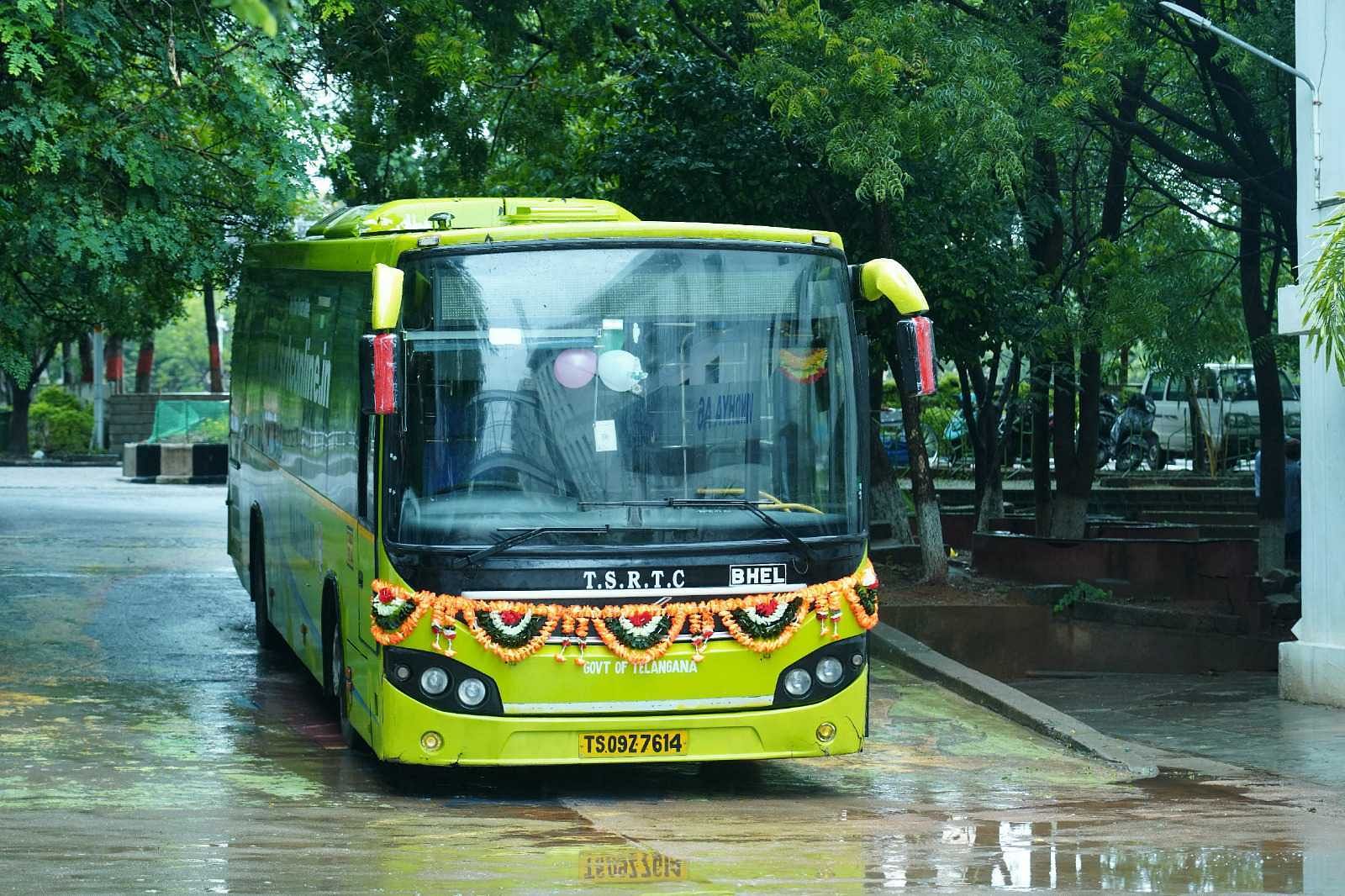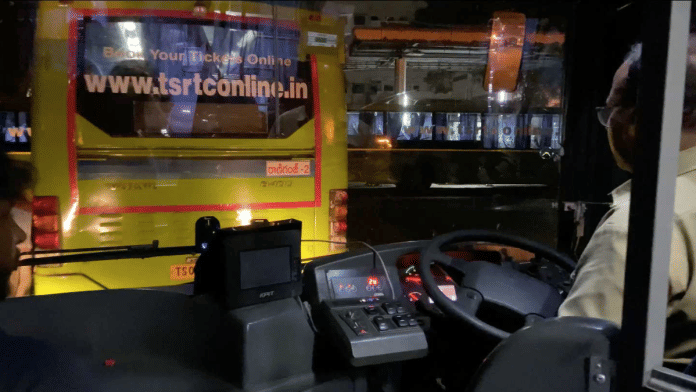New Delhi: An Artificial Intelligence-powered alert system installed in Telangana state transport buses as part of a pilot project has demonstrated a 40 percent reduction in accidents over the past year.
The Advanced Driver Assistance System (ADAS) was installed on 200 buses plying three national highways in the state — Hyderabad-Bengaluru, Hyderabad-Vijaywada and Hyderabad-Nagpur.
The pilot project was initiated in September 2022, as part of the Telangana government’s attempts to reduce accidents on highways. Telangana is among India’s 10 states with the highest number of accidents and fatalities on highways, according to the Ministry of Road Transport and Highways’ ‘Road Accidents in India-2022’ report. In 2022, the state recorded 7,505 accidents on highways with 3,010 fatalities.
Called iRASTE (Intelligent Solution for Road Safety Through Technology and Engineering), the pilot project demonstrated a 40 percent reduction in road accidents involving state transport buses equipped with AI-enabled ADAS devices as compared to non-ADAS buses in the past one year. The device alerts the driver about possible collisions, distance between vehicles, speed limits etc. It has also helped identify 60 accident-prone areas (grey spots) on the three national highways in the state using AI algorithms, according to initial findings.
iRASTE is a collaboration between the Centre, INAI, an Applied AI Research Centre at the International Institute of Information Technology, Hyderabad, the Council of Scientific and Industrial Research-Central Road Research Institute (CSIR-CRRI), Intel, and the Telangana government. It was implemented in Nagpur and on three national highways in Telangana. Spearheaded by INAI — a joint initiative of IIIT-Hyderabad, Telangana government, and Intel — the project focuses on using AI to address road safety and mobility, and healthcare challenges.
Road safety experts involved in the project say the pilots in Nagpur and selected highways of Telangana have shown that ADAS technology can play a crucial role in reducing crashes.
“A major outcome of the pilot project is that the number of fatal road accidents, between March 2023 and April 2024, involving state transport buses on the selected highway corridors in Telangana was 40 percent lower in buses which had ADAS devices as compared to non-ADAS buses,” said Varma S Konala, chief executive officer of INAI.
Konala said the final report on the outcome of the study will be submitted to the Telangana government and the Centre next month.
The Telangana State Road Transport Corporation (TSRTC) is now planning to install the ADAS devices in its buses on a large scale, two senior TSRTC officials told ThePrint.
“The pilot project is now over. While the final report is yet to be submitted, we are planning to float tenders for installation of ADAS devices in our buses to enhance safety. The number of buses is yet to be decided,” said a senior TSRTC official.
Also Read: ‘We are frustrated citizens in Pune now’. Porsche incident has killed the city’s vibe
Similar results in Nagpur too
As part of the hi-tech road safety initiative, a pilot project was implemented in Nagpur in collaboration with the Nagpur Municipal Corporation to assess the benefit of the technology in the traffic situation in the city. The ADAS device was installed in 150 buses operated by the Nagpur Municipal Corporation.
“In Nagpur also we found 41 percent lower accidents in buses equipped with ADAS as compared to non-ADAS buses. The technology plays a crucial role in bringing down accidents on city roads, which are used by pedestrians, cyclists, cars, trucks etc. The bus drivers have to be very careful as speed limits vary on different road stretches in cities. Another factor is the high pedestrian movement on city roads which increases the chances of accidents,” said Mukti Advani, senior principal scientist, CSIR-CRRI.
With the Centre pushing for improving bus transport infrastructure in the country, especially promoting the use of electric buses, transport experts say there is a need to equip them with systems to prevent accidents.
According to the road transport ministry’s report in 2022, there was a 40.9 percent increase in bus-related accidents on national highways in 2022 as compared to 2021. In 2022, 5,268 accidents involving buses were reported on national highways as against 3,738 in 2021.
T Surya Kiran, executive director at the Association of State Road Transport Undertakings, which is the apex coordinating body representing 80 state transport undertakings in India, said that other state governments are exploring the possibility of implementing a similar initiative after the promising outcome of the iRASTE pilot.
“We have asked all state transport undertakings to explore the use of ADAS devices to reduce accidents. A team from Gujarat’s state road transport recently visited Hyderabad to study the initiative. Given the high rate of highway accidents, implementing safety measures is crucial to saving lives and this initiative can be extremely useful,” he said.

How ADAS works
The AI-powered ADAS devices help generate real-time alerts to caution bus drivers about possible collisions, speed limit on roads, distance between vehicles in the front etc.
The main component of an ADAS device is a camera unit focused on the road, and a display unit. The camera unit has a processor that processes video data using algorithms to detect risks in real time.
“The ADAS device is also connected to the engine and other parts of the bus. It generates real time audio and video alerts to caution the driver to maintain a safe distance from the vehicle in the front to prevent collision and about pedestrians near the bus. It also alerts if the driver changes lanes without using an indicator. The device also collects data about the speed at the corridors etc,” said S Velmurugan, chief scientist and head of the department of traffic engineering and safety division at CSIR-CRRI in Delhi.
He said one of the major reasons for accidents on roads, especially highways, is speed and the ADAS helps to keep a check on it. “The camera can read the speed limit boards on roads and alert the driver about it. It constantly monitors the speed of the bus while in use. The information of all the alerts generated in a bus is also sent to a cloud portal which archives all such events for detailed analysis,” said Velmurugan.
In Telangana, a Driver Monitoring System (DMS) device was also installed in 10 buses to observe the driving behaviour of the drivers.
“In addition to ADAS, we also used the DMS in a select few buses to alert drivers about drowsiness and sleeping conditions. The combination of ADAS + DMS alert data provides valuable insights, for instance near-miss accidents, whether he is using mobile while driving, in understanding the drivers’ behaviour and providing them more customized training,” said Konala.
Identifying accident-prone areas
The pilot project has been crucial in identifying grey spots.
“To declare a road section a black spot on highways, there must be at least 10 fatalities or 5 accidents on a 500 m stretch within three years. Our AI predictive model can identify grey spots, which are potential black spots, so that corrective measures can be taken to prevent future accidents. Grey spots are determined using data from ADAS devices, including vehicle speed, geographical conditions, and system alerts,” said Govind Krishnan, program manager, iRASTE.
In Telangana, for instance, 60 grey spots were identified on the three national highways during the study period using the AI technology.
“Artificial Intelligence-based algorithm is used to predict future black spots based on the data collected from ADAS and road geometry. We have been able to identify 60 grey spots. The road owning agencies can take remedial measures, including making changes in road design, to prevent accidents based on the grey spot information,” said Konala.
This is an updated version of the story.
(Edited by Gitanjali Das)
Also Read: CBI officer dies in motorcycle accident in Jammu. Family, PDP demands thorough probe






